PLSC101 Assignment: Eradicating Poverty, Crime, and Disease in Society
VerifiedAdded on 2022/09/11
|7
|1620
|16
Essay
AI Summary
This essay delves into the interconnected issues of poverty, crime, and disease, exploring their impact on society and identifying potential solutions. It examines poverty as a minimum living condition, crime as a consequence of various societal factors, and disease as a result of socioeconomic conditions and environmental pressures. The essay highlights the importance of education, healthcare, and financial systems in reducing poverty, while also emphasizing community participation, technological advancements, and crime prevention education to combat crime. Furthermore, it discusses risk reduction strategies, social media promotion, and community preparedness as essential tools to fight against disease. The essay concludes by emphasizing the need for comprehensive and robust measures to address these complex challenges and create a healthier, more equitable future for all.
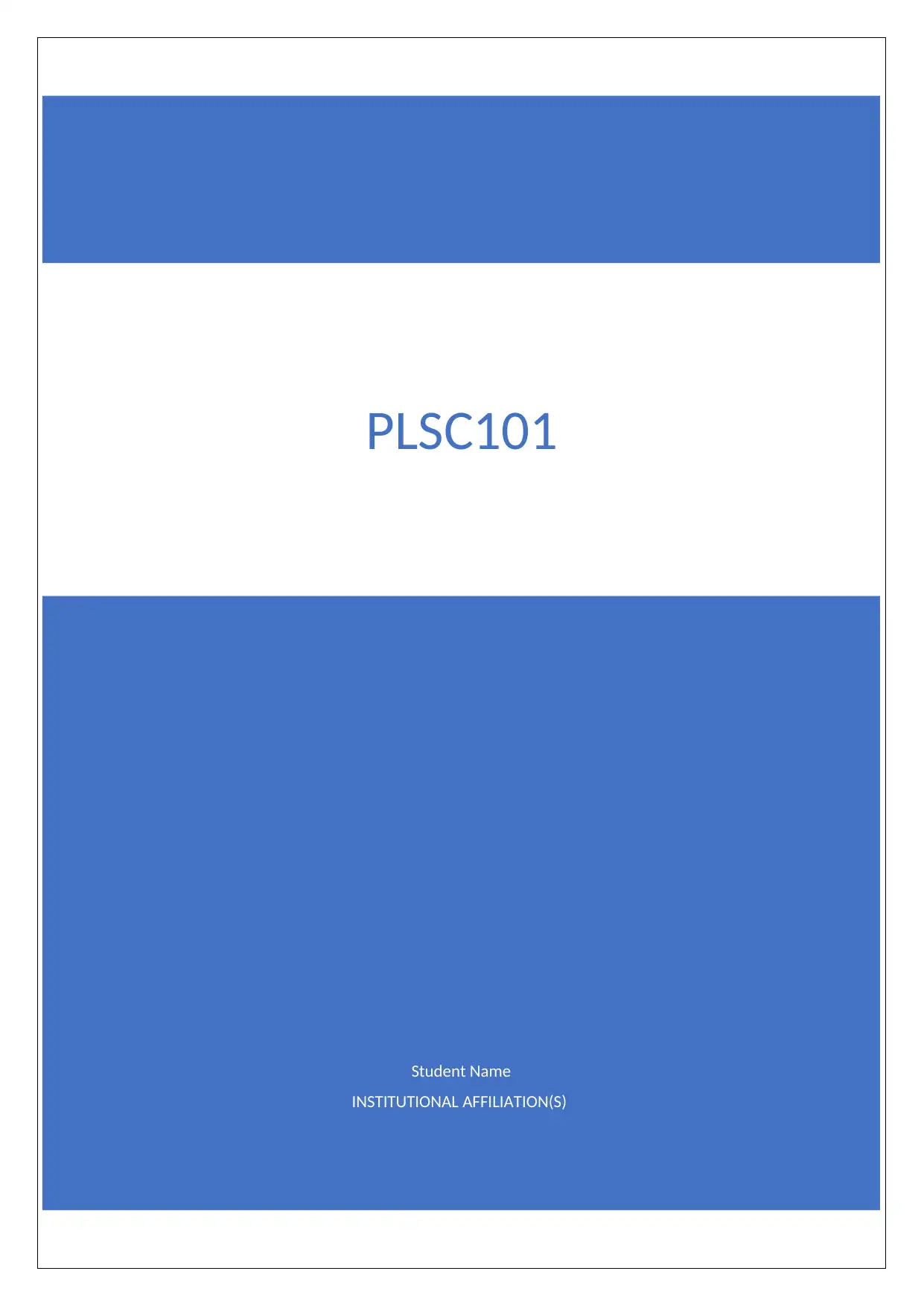
Student Name
INSTITUTIONAL AFFILIATION(S)
PLSC101
INSTITUTIONAL AFFILIATION(S)
PLSC101
Paraphrase This Document
Need a fresh take? Get an instant paraphrase of this document with our AI Paraphraser
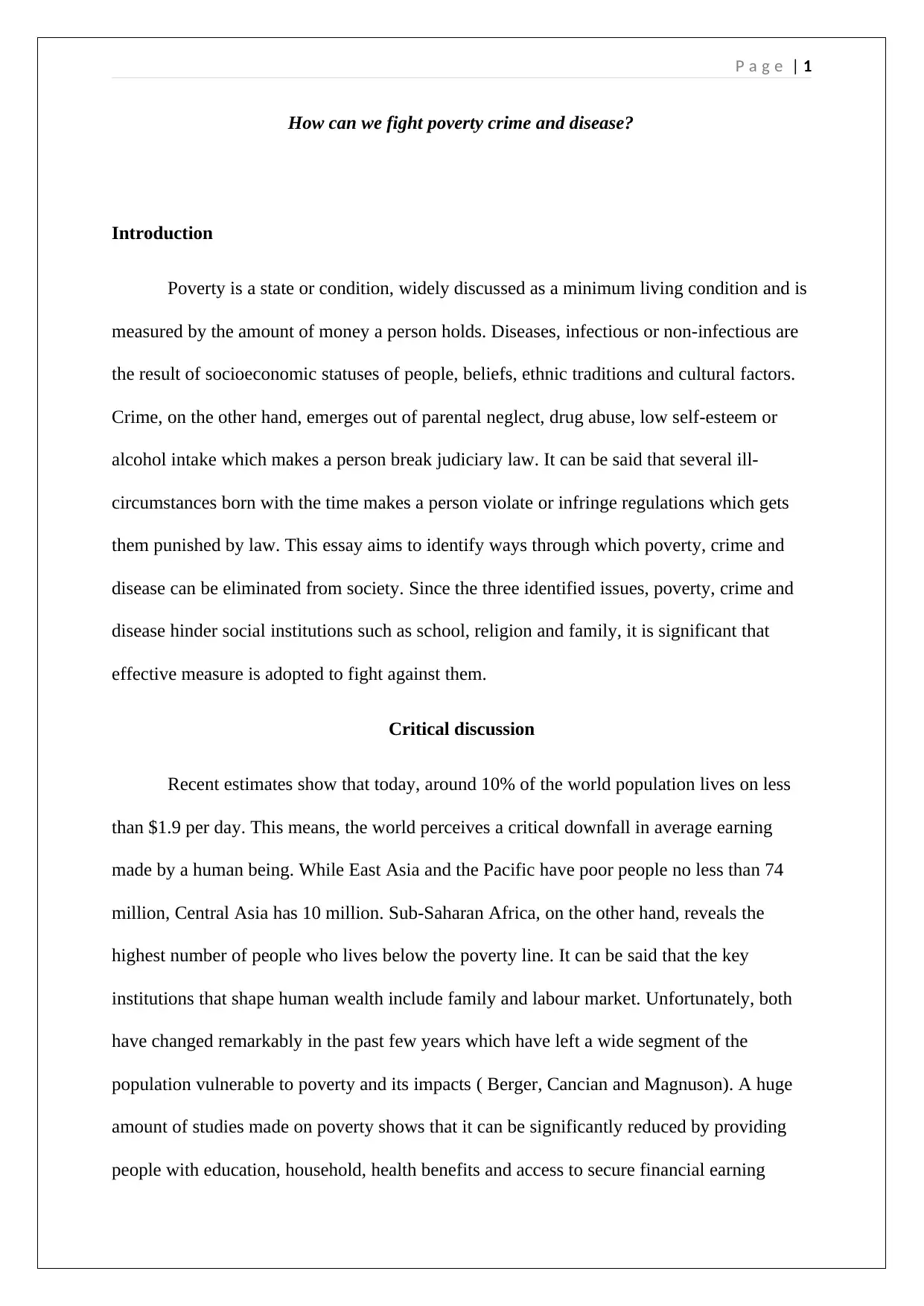
P a g e | 1
How can we fight poverty crime and disease?
Introduction
Poverty is a state or condition, widely discussed as a minimum living condition and is
measured by the amount of money a person holds. Diseases, infectious or non-infectious are
the result of socioeconomic statuses of people, beliefs, ethnic traditions and cultural factors.
Crime, on the other hand, emerges out of parental neglect, drug abuse, low self-esteem or
alcohol intake which makes a person break judiciary law. It can be said that several ill-
circumstances born with the time makes a person violate or infringe regulations which gets
them punished by law. This essay aims to identify ways through which poverty, crime and
disease can be eliminated from society. Since the three identified issues, poverty, crime and
disease hinder social institutions such as school, religion and family, it is significant that
effective measure is adopted to fight against them.
Critical discussion
Recent estimates show that today, around 10% of the world population lives on less
than $1.9 per day. This means, the world perceives a critical downfall in average earning
made by a human being. While East Asia and the Pacific have poor people no less than 74
million, Central Asia has 10 million. Sub-Saharan Africa, on the other hand, reveals the
highest number of people who lives below the poverty line. It can be said that the key
institutions that shape human wealth include family and labour market. Unfortunately, both
have changed remarkably in the past few years which have left a wide segment of the
population vulnerable to poverty and its impacts ( Berger, Cancian and Magnuson). A huge
amount of studies made on poverty shows that it can be significantly reduced by providing
people with education, household, health benefits and access to secure financial earning
How can we fight poverty crime and disease?
Introduction
Poverty is a state or condition, widely discussed as a minimum living condition and is
measured by the amount of money a person holds. Diseases, infectious or non-infectious are
the result of socioeconomic statuses of people, beliefs, ethnic traditions and cultural factors.
Crime, on the other hand, emerges out of parental neglect, drug abuse, low self-esteem or
alcohol intake which makes a person break judiciary law. It can be said that several ill-
circumstances born with the time makes a person violate or infringe regulations which gets
them punished by law. This essay aims to identify ways through which poverty, crime and
disease can be eliminated from society. Since the three identified issues, poverty, crime and
disease hinder social institutions such as school, religion and family, it is significant that
effective measure is adopted to fight against them.
Critical discussion
Recent estimates show that today, around 10% of the world population lives on less
than $1.9 per day. This means, the world perceives a critical downfall in average earning
made by a human being. While East Asia and the Pacific have poor people no less than 74
million, Central Asia has 10 million. Sub-Saharan Africa, on the other hand, reveals the
highest number of people who lives below the poverty line. It can be said that the key
institutions that shape human wealth include family and labour market. Unfortunately, both
have changed remarkably in the past few years which have left a wide segment of the
population vulnerable to poverty and its impacts ( Berger, Cancian and Magnuson). A huge
amount of studies made on poverty shows that it can be significantly reduced by providing
people with education, household, health benefits and access to secure financial earning
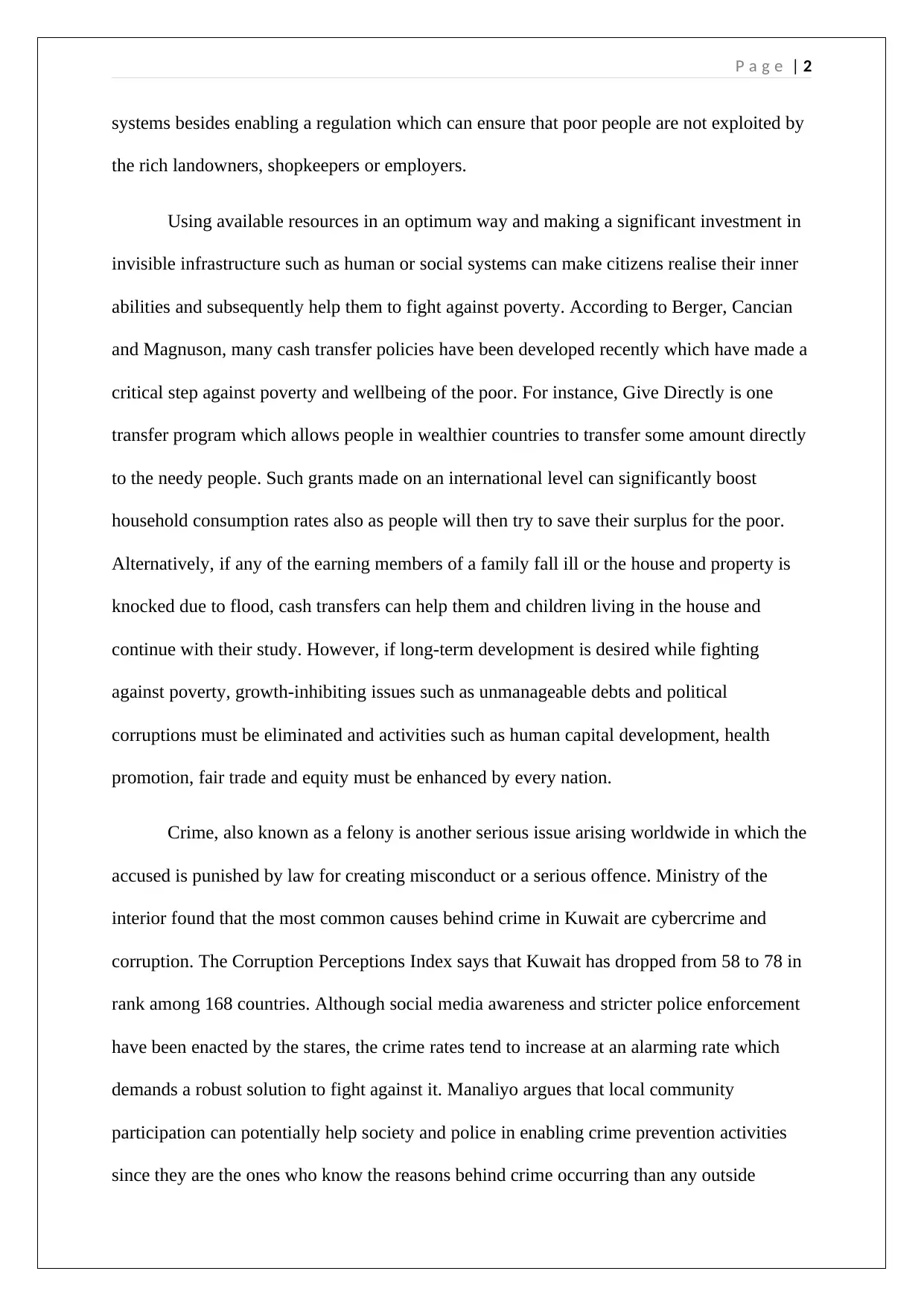
P a g e | 2
systems besides enabling a regulation which can ensure that poor people are not exploited by
the rich landowners, shopkeepers or employers.
Using available resources in an optimum way and making a significant investment in
invisible infrastructure such as human or social systems can make citizens realise their inner
abilities and subsequently help them to fight against poverty. According to Berger, Cancian
and Magnuson, many cash transfer policies have been developed recently which have made a
critical step against poverty and wellbeing of the poor. For instance, Give Directly is one
transfer program which allows people in wealthier countries to transfer some amount directly
to the needy people. Such grants made on an international level can significantly boost
household consumption rates also as people will then try to save their surplus for the poor.
Alternatively, if any of the earning members of a family fall ill or the house and property is
knocked due to flood, cash transfers can help them and children living in the house and
continue with their study. However, if long-term development is desired while fighting
against poverty, growth-inhibiting issues such as unmanageable debts and political
corruptions must be eliminated and activities such as human capital development, health
promotion, fair trade and equity must be enhanced by every nation.
Crime, also known as a felony is another serious issue arising worldwide in which the
accused is punished by law for creating misconduct or a serious offence. Ministry of the
interior found that the most common causes behind crime in Kuwait are cybercrime and
corruption. The Corruption Perceptions Index says that Kuwait has dropped from 58 to 78 in
rank among 168 countries. Although social media awareness and stricter police enforcement
have been enacted by the stares, the crime rates tend to increase at an alarming rate which
demands a robust solution to fight against it. Manaliyo argues that local community
participation can potentially help society and police in enabling crime prevention activities
since they are the ones who know the reasons behind crime occurring than any outside
systems besides enabling a regulation which can ensure that poor people are not exploited by
the rich landowners, shopkeepers or employers.
Using available resources in an optimum way and making a significant investment in
invisible infrastructure such as human or social systems can make citizens realise their inner
abilities and subsequently help them to fight against poverty. According to Berger, Cancian
and Magnuson, many cash transfer policies have been developed recently which have made a
critical step against poverty and wellbeing of the poor. For instance, Give Directly is one
transfer program which allows people in wealthier countries to transfer some amount directly
to the needy people. Such grants made on an international level can significantly boost
household consumption rates also as people will then try to save their surplus for the poor.
Alternatively, if any of the earning members of a family fall ill or the house and property is
knocked due to flood, cash transfers can help them and children living in the house and
continue with their study. However, if long-term development is desired while fighting
against poverty, growth-inhibiting issues such as unmanageable debts and political
corruptions must be eliminated and activities such as human capital development, health
promotion, fair trade and equity must be enhanced by every nation.
Crime, also known as a felony is another serious issue arising worldwide in which the
accused is punished by law for creating misconduct or a serious offence. Ministry of the
interior found that the most common causes behind crime in Kuwait are cybercrime and
corruption. The Corruption Perceptions Index says that Kuwait has dropped from 58 to 78 in
rank among 168 countries. Although social media awareness and stricter police enforcement
have been enacted by the stares, the crime rates tend to increase at an alarming rate which
demands a robust solution to fight against it. Manaliyo argues that local community
participation can potentially help society and police in enabling crime prevention activities
since they are the ones who know the reasons behind crime occurring than any outside
⊘ This is a preview!⊘
Do you want full access?
Subscribe today to unlock all pages.

Trusted by 1+ million students worldwide
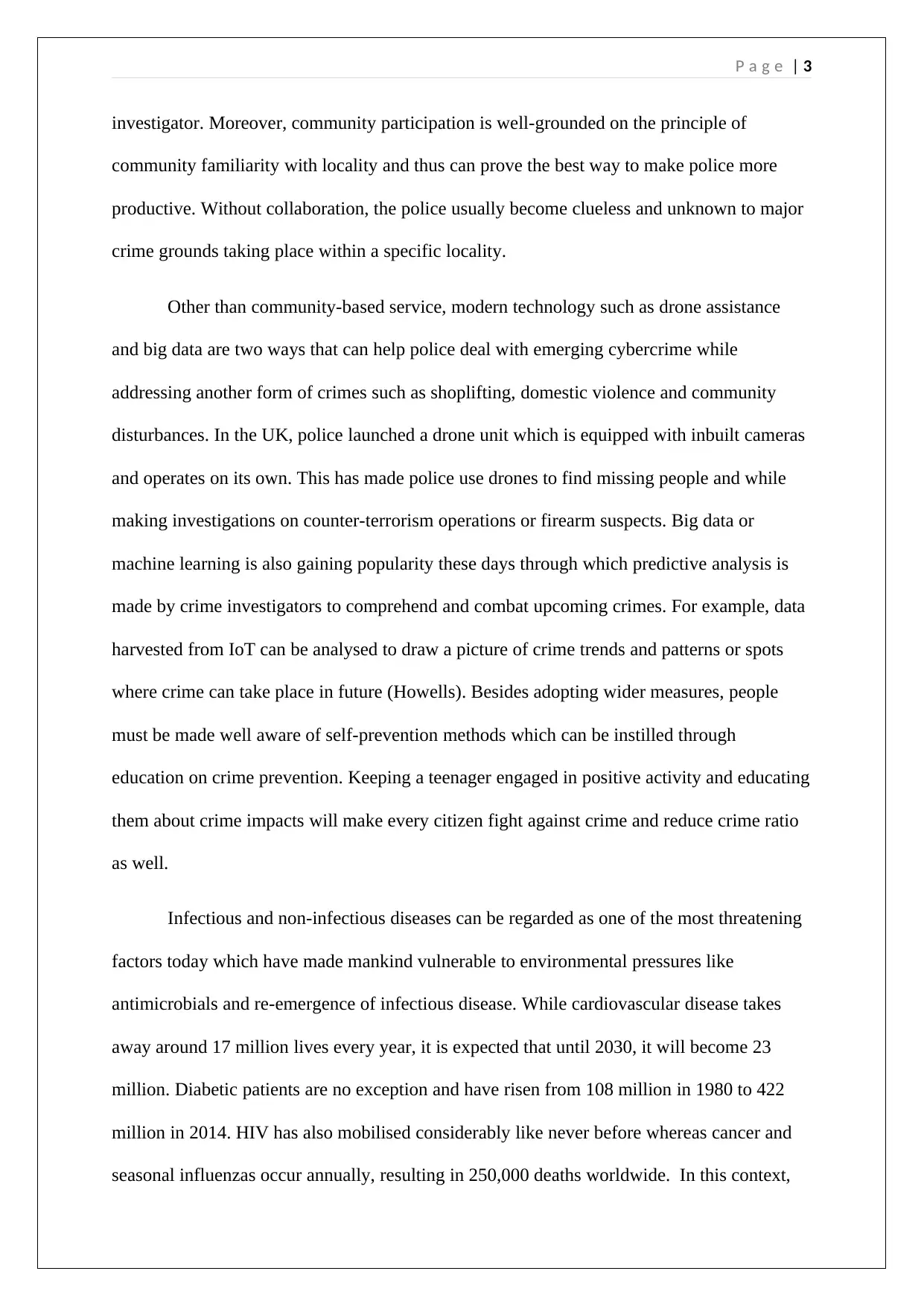
P a g e | 3
investigator. Moreover, community participation is well-grounded on the principle of
community familiarity with locality and thus can prove the best way to make police more
productive. Without collaboration, the police usually become clueless and unknown to major
crime grounds taking place within a specific locality.
Other than community-based service, modern technology such as drone assistance
and big data are two ways that can help police deal with emerging cybercrime while
addressing another form of crimes such as shoplifting, domestic violence and community
disturbances. In the UK, police launched a drone unit which is equipped with inbuilt cameras
and operates on its own. This has made police use drones to find missing people and while
making investigations on counter-terrorism operations or firearm suspects. Big data or
machine learning is also gaining popularity these days through which predictive analysis is
made by crime investigators to comprehend and combat upcoming crimes. For example, data
harvested from IoT can be analysed to draw a picture of crime trends and patterns or spots
where crime can take place in future (Howells). Besides adopting wider measures, people
must be made well aware of self-prevention methods which can be instilled through
education on crime prevention. Keeping a teenager engaged in positive activity and educating
them about crime impacts will make every citizen fight against crime and reduce crime ratio
as well.
Infectious and non-infectious diseases can be regarded as one of the most threatening
factors today which have made mankind vulnerable to environmental pressures like
antimicrobials and re-emergence of infectious disease. While cardiovascular disease takes
away around 17 million lives every year, it is expected that until 2030, it will become 23
million. Diabetic patients are no exception and have risen from 108 million in 1980 to 422
million in 2014. HIV has also mobilised considerably like never before whereas cancer and
seasonal influenzas occur annually, resulting in 250,000 deaths worldwide. In this context,
investigator. Moreover, community participation is well-grounded on the principle of
community familiarity with locality and thus can prove the best way to make police more
productive. Without collaboration, the police usually become clueless and unknown to major
crime grounds taking place within a specific locality.
Other than community-based service, modern technology such as drone assistance
and big data are two ways that can help police deal with emerging cybercrime while
addressing another form of crimes such as shoplifting, domestic violence and community
disturbances. In the UK, police launched a drone unit which is equipped with inbuilt cameras
and operates on its own. This has made police use drones to find missing people and while
making investigations on counter-terrorism operations or firearm suspects. Big data or
machine learning is also gaining popularity these days through which predictive analysis is
made by crime investigators to comprehend and combat upcoming crimes. For example, data
harvested from IoT can be analysed to draw a picture of crime trends and patterns or spots
where crime can take place in future (Howells). Besides adopting wider measures, people
must be made well aware of self-prevention methods which can be instilled through
education on crime prevention. Keeping a teenager engaged in positive activity and educating
them about crime impacts will make every citizen fight against crime and reduce crime ratio
as well.
Infectious and non-infectious diseases can be regarded as one of the most threatening
factors today which have made mankind vulnerable to environmental pressures like
antimicrobials and re-emergence of infectious disease. While cardiovascular disease takes
away around 17 million lives every year, it is expected that until 2030, it will become 23
million. Diabetic patients are no exception and have risen from 108 million in 1980 to 422
million in 2014. HIV has also mobilised considerably like never before whereas cancer and
seasonal influenzas occur annually, resulting in 250,000 deaths worldwide. In this context,
Paraphrase This Document
Need a fresh take? Get an instant paraphrase of this document with our AI Paraphraser
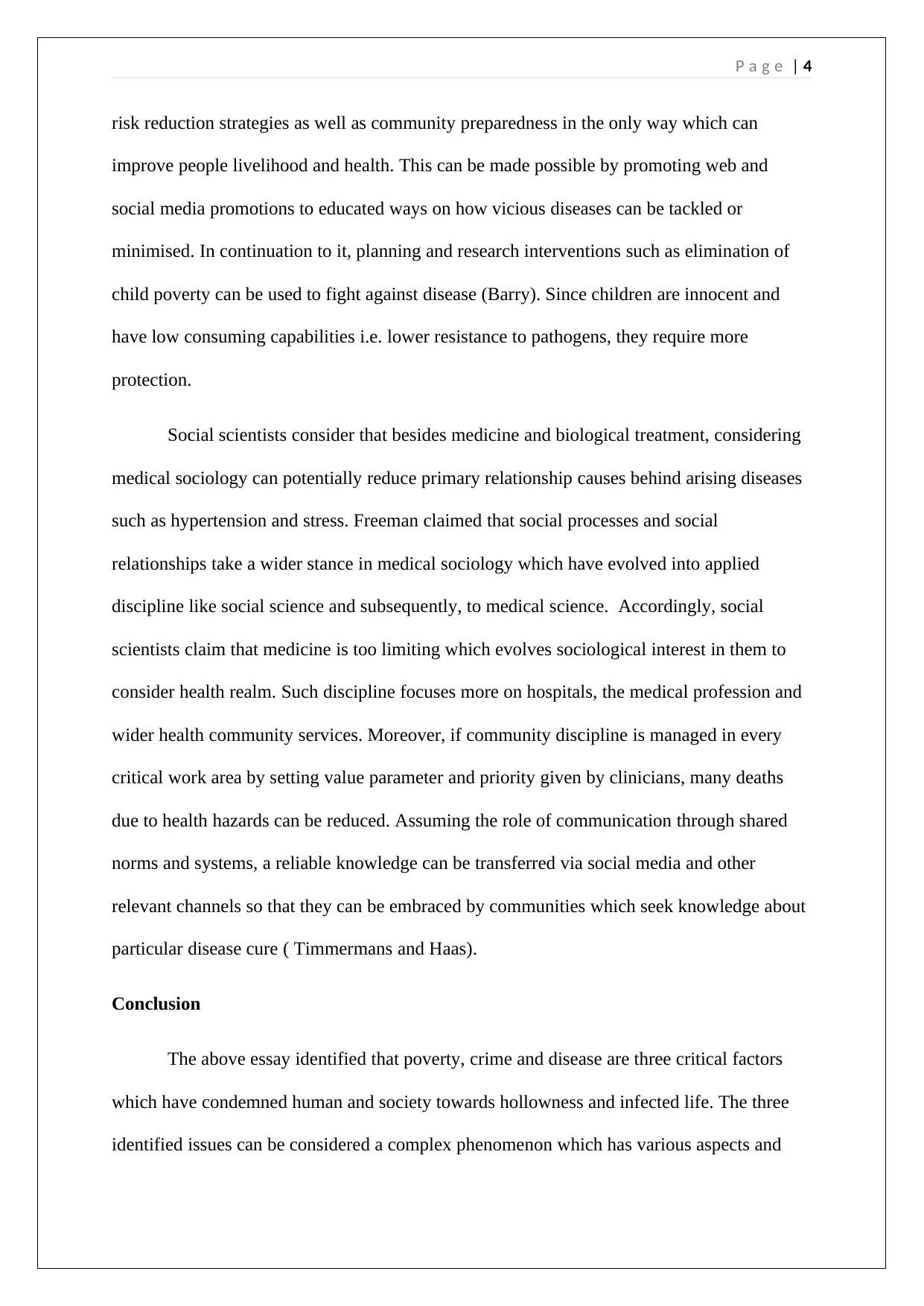
P a g e | 4
risk reduction strategies as well as community preparedness in the only way which can
improve people livelihood and health. This can be made possible by promoting web and
social media promotions to educated ways on how vicious diseases can be tackled or
minimised. In continuation to it, planning and research interventions such as elimination of
child poverty can be used to fight against disease (Barry). Since children are innocent and
have low consuming capabilities i.e. lower resistance to pathogens, they require more
protection.
Social scientists consider that besides medicine and biological treatment, considering
medical sociology can potentially reduce primary relationship causes behind arising diseases
such as hypertension and stress. Freeman claimed that social processes and social
relationships take a wider stance in medical sociology which have evolved into applied
discipline like social science and subsequently, to medical science. Accordingly, social
scientists claim that medicine is too limiting which evolves sociological interest in them to
consider health realm. Such discipline focuses more on hospitals, the medical profession and
wider health community services. Moreover, if community discipline is managed in every
critical work area by setting value parameter and priority given by clinicians, many deaths
due to health hazards can be reduced. Assuming the role of communication through shared
norms and systems, a reliable knowledge can be transferred via social media and other
relevant channels so that they can be embraced by communities which seek knowledge about
particular disease cure ( Timmermans and Haas).
Conclusion
The above essay identified that poverty, crime and disease are three critical factors
which have condemned human and society towards hollowness and infected life. The three
identified issues can be considered a complex phenomenon which has various aspects and
risk reduction strategies as well as community preparedness in the only way which can
improve people livelihood and health. This can be made possible by promoting web and
social media promotions to educated ways on how vicious diseases can be tackled or
minimised. In continuation to it, planning and research interventions such as elimination of
child poverty can be used to fight against disease (Barry). Since children are innocent and
have low consuming capabilities i.e. lower resistance to pathogens, they require more
protection.
Social scientists consider that besides medicine and biological treatment, considering
medical sociology can potentially reduce primary relationship causes behind arising diseases
such as hypertension and stress. Freeman claimed that social processes and social
relationships take a wider stance in medical sociology which have evolved into applied
discipline like social science and subsequently, to medical science. Accordingly, social
scientists claim that medicine is too limiting which evolves sociological interest in them to
consider health realm. Such discipline focuses more on hospitals, the medical profession and
wider health community services. Moreover, if community discipline is managed in every
critical work area by setting value parameter and priority given by clinicians, many deaths
due to health hazards can be reduced. Assuming the role of communication through shared
norms and systems, a reliable knowledge can be transferred via social media and other
relevant channels so that they can be embraced by communities which seek knowledge about
particular disease cure ( Timmermans and Haas).
Conclusion
The above essay identified that poverty, crime and disease are three critical factors
which have condemned human and society towards hollowness and infected life. The three
identified issues can be considered a complex phenomenon which has various aspects and
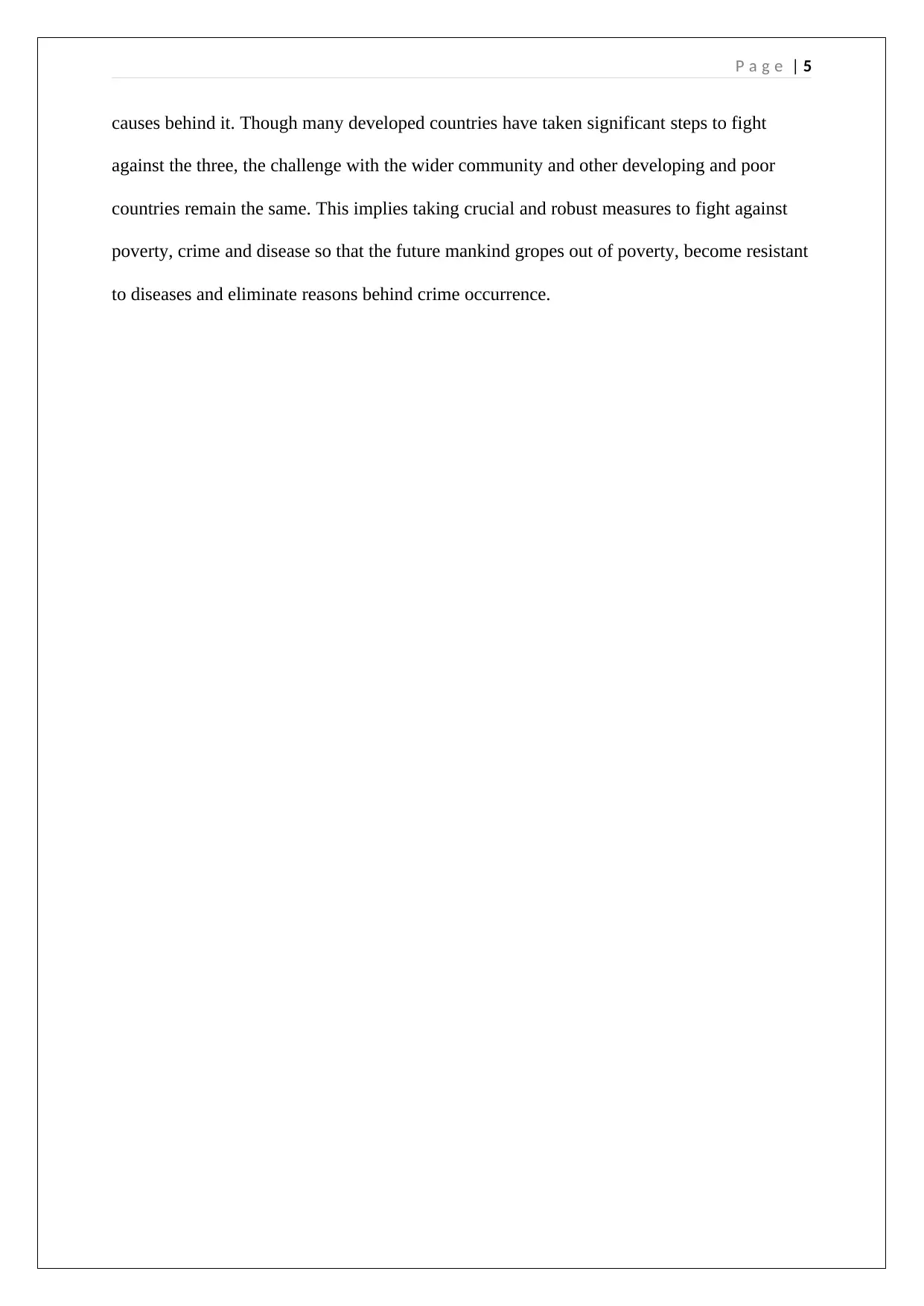
P a g e | 5
causes behind it. Though many developed countries have taken significant steps to fight
against the three, the challenge with the wider community and other developing and poor
countries remain the same. This implies taking crucial and robust measures to fight against
poverty, crime and disease so that the future mankind gropes out of poverty, become resistant
to diseases and eliminate reasons behind crime occurrence.
causes behind it. Though many developed countries have taken significant steps to fight
against the three, the challenge with the wider community and other developing and poor
countries remain the same. This implies taking crucial and robust measures to fight against
poverty, crime and disease so that the future mankind gropes out of poverty, become resistant
to diseases and eliminate reasons behind crime occurrence.
⊘ This is a preview!⊘
Do you want full access?
Subscribe today to unlock all pages.

Trusted by 1+ million students worldwide
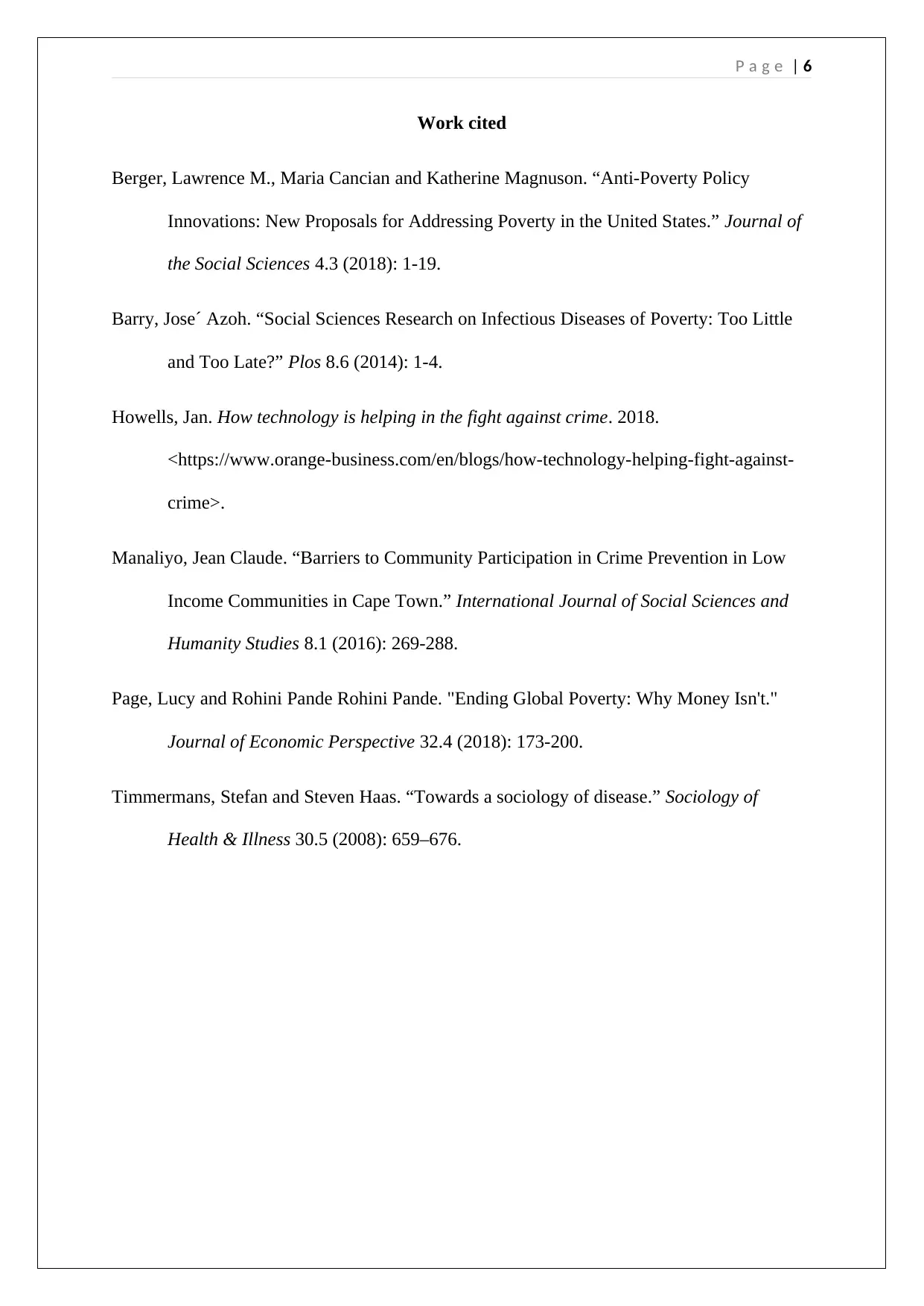
P a g e | 6
Work cited
Berger, Lawrence M., Maria Cancian and Katherine Magnuson. “Anti-Poverty Policy
Innovations: New Proposals for Addressing Poverty in the United States.” Journal of
the Social Sciences 4.3 (2018): 1-19.
Barry, Jose´ Azoh. “Social Sciences Research on Infectious Diseases of Poverty: Too Little
and Too Late?” Plos 8.6 (2014): 1-4.
Howells, Jan. How technology is helping in the fight against crime. 2018.
<https://www.orange-business.com/en/blogs/how-technology-helping-fight-against-
crime>.
Manaliyo, Jean Claude. “Barriers to Community Participation in Crime Prevention in Low
Income Communities in Cape Town.” International Journal of Social Sciences and
Humanity Studies 8.1 (2016): 269-288.
Page, Lucy and Rohini Pande Rohini Pande. "Ending Global Poverty: Why Money Isn't."
Journal of Economic Perspective 32.4 (2018): 173-200.
Timmermans, Stefan and Steven Haas. “Towards a sociology of disease.” Sociology of
Health & Illness 30.5 (2008): 659–676.
Work cited
Berger, Lawrence M., Maria Cancian and Katherine Magnuson. “Anti-Poverty Policy
Innovations: New Proposals for Addressing Poverty in the United States.” Journal of
the Social Sciences 4.3 (2018): 1-19.
Barry, Jose´ Azoh. “Social Sciences Research on Infectious Diseases of Poverty: Too Little
and Too Late?” Plos 8.6 (2014): 1-4.
Howells, Jan. How technology is helping in the fight against crime. 2018.
<https://www.orange-business.com/en/blogs/how-technology-helping-fight-against-
crime>.
Manaliyo, Jean Claude. “Barriers to Community Participation in Crime Prevention in Low
Income Communities in Cape Town.” International Journal of Social Sciences and
Humanity Studies 8.1 (2016): 269-288.
Page, Lucy and Rohini Pande Rohini Pande. "Ending Global Poverty: Why Money Isn't."
Journal of Economic Perspective 32.4 (2018): 173-200.
Timmermans, Stefan and Steven Haas. “Towards a sociology of disease.” Sociology of
Health & Illness 30.5 (2008): 659–676.
1 out of 7
Related Documents
Your All-in-One AI-Powered Toolkit for Academic Success.
+13062052269
info@desklib.com
Available 24*7 on WhatsApp / Email
![[object Object]](/_next/static/media/star-bottom.7253800d.svg)
Unlock your academic potential
Copyright © 2020–2025 A2Z Services. All Rights Reserved. Developed and managed by ZUCOL.





